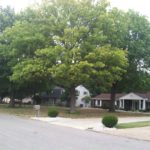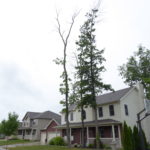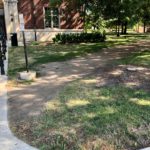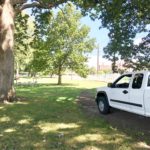Many tree issues are relatively easy to diagnose, especially when it comes to insects or diseases attacking the leaves or branches, or problems with the above ground part of the tree. However, when it comes to diagnosing issues below ground, where the roots are located, it becomes a bit tricky.
Often, we see trees suffering, especially during the summer months with chlorotic leaves, smaller leaf size or thinning canopy. Most tree owners suspect it’s a pest issue and turn to chemical sprays or fertilizers to improve the situation. However, chemical applications won’t help your tree if there is compaction in the root zone.
Compaction is one of the biggest health risks to trees and is caused by excessive traffic or activity on the soil around the root zone. This compaction or compression occurs because excessive weight can press the soil particles together very tightly reducing the pore space between them which holds vital air and water. This air and water is required for roots to take up water in the soil and for roots to breathe.
Many things cause this compression of soil particles, including lawn maintenance activities, vehicles parked on or driving over the tree root zone, flooding or lack of drainage, and most unmonitored construction activities. Construction equipment is the biggest contributor to soil compression and adverse effects on trees. Even constant foot traffic in the same areas can cause soil compaction. The best remedy for compaction is to prevent it in the first place. Designated paths, and restriction of activity such as parking on and driving around trees can help greatly.
- Construction activities compress soil particles making it challenging for roots to survive.
- Constant foot traffic can cause compaction making it a challenge to grow turf or trees.
- Parking and driving on tree roots can cause long-term damage and death.
When we see the tree is not doing well because of unexplained decline, such as early fall color or other symptoms mentioned earlier; we must look to see what the underlying problem that is causing the tree health issues. If we determine compaction is the main reason, we can understand there isn’t an easy remedy. But, there is help…
If you suspect compaction to be an issue, contact an ISA Certified Arborist to review the site conditions, assess tree health and inspect the soil around the tree. Often the compaction can be assisted with good cultural practices such as keeping off the root zone, adding mulch, and supplemental irrigation. In severe cases, the tree can be saved with the use of air excavation tools. Professional arborists have special tools to loosen the soil and add suitable soil replacements to improve aeration and water infiltration. In these cases, this is often the best way to improve tree health.
For this issue and any other tree care challenges, always consult an International Society of Arboriculture Certified Arborist to review your tree and get the best remedy for your situation.
The best place to look for an arborist in your area is www.treesaregood.org.
To learn more about construction damage and compaction, refer to the Purdue education store for these publications.



